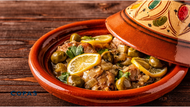A Taste of Morocco: Chicken Tagine with Lemon
Posted by Copas Farm Shop on 23rd Sep 2025
Cooking a tagine always feels a little bit special, it’s not the sort of dish most of us make every week, but that’s exactly what makes it such a treat. The gentle spices, bright lemon and tender chicken of this recipe bring a touch of North African sunshine to the table, yet it’s surprisingly simple to prepare. And if you’ve never made one, or even tasted a tagine before, this recipe is the perfect place to start. With Copas free-range chicken at the heart of it, you get a dish that’s both comforting and a little out of the ordinary.
A Little Background on Tagines
The word tagine (or tajine) refers both to the cooking vessel itself and the slow-cooked stews that are prepared inside it. The pot is distinctive, wide and shallow at the base with a tall, conical lid. The design is ingenious: as the food cooks gently, steam rises, condenses on the lid, and drips back down to baste the ingredients, keeping everything moist and full of flavour.
Tagine cooking originates from the Berber people of North Africa, particularly Morocco, and has been part of everyday life there for centuries. Over time, the dish absorbed influences from Arab, Moorish, Andalusian and even French cuisines, creating the richly spiced, citrusy and sometimes sweet-savoured combinations we recognise today. Traditionally, a tagine might be simmered slowly over hot coals, but modern kitchens achieve just as wonderful results with a stove-top or oven-friendly casserole dish.
That’s part of the beauty of a tagine: it feels exotic and steeped in history, but it’s very achievable at home with a few spices, good chicken, and a little patience.
My Recipe: Hearty Free-Range Chicken Tagine with Lemon
This version is rooted in classic Moroccan flavours but tailored to be a hearty, family-friendly dish. It comfortably serves 4–6 people, and while it tastes like you’ve worked for hours, most of the cooking is hands-off.
Ingredients
- 1.5 kg free-range chicken pieces (thighs and drumsticks are best; bone-in gives the richest flavour)
- 2–3 tablespoons olive oil
- 1 large onion, finely sliced
- 3 cloves garlic, crushed
- 1 teaspoon ground ginger
- 1 teaspoon ground cumin
- ½ teaspoon ground turmeric
- ½ teaspoon ground cinnamon
- ½ teaspoon paprika (smoked or sweet, whichever you prefer)
- Sea salt and freshly ground black pepper
- 1 preserved lemon, rinsed, pulp removed, rind thinly sliced
- Juice and zest of 1 fresh lemon
- 100g green olives, pitted
- Small bunch of fresh coriander, chopped
- Optional: handful of fresh parsley, chopped
- 200–250ml chicken stock (homemade or good quality)
- 1–2 tablespoons honey (optional, to balance the lemon)
- Optional vegetables: carrots, potatoes, or courgettes if you’d like to bulk it out
Method
- Prepare the chicken: Pat the pieces dry and season lightly with salt and pepper.
- Brown for flavour: Heat olive oil in your tagine pot (or a heavy casserole dish if you don’t have one). Brown the chicken pieces on all sides, then set aside.
- Soften the base: Lower the heat, add the sliced onion, and cook until soft and translucent (5–7 minutes). Stir in the garlic and cook for another minute.
- Spice it up: Add the ground ginger, cumin, turmeric, cinnamon, and paprika. Toast the spices gently for about 30 seconds – this wakes up their aroma.
- Build the dish: Return the chicken to the pot. Stir through the preserved lemon rind, lemon juice and zest. Pour in enough chicken stock to come about halfway up the meat. If adding firm vegetables like carrots or potatoes, pop them in now.
- Low and slow: Bring to a gentle simmer, then cover. Cook for 45–60 minutes on the lowest heat, turning the chicken once or twice. The meat should be tender and the sauce rich and slightly thickened.
- Finishing touches: Ten minutes before serving, add the olives and chopped herbs. Stir in honey if you’d like to mellow the sharpness of the lemon. Taste and adjust seasoning.
- Serve: Scatter with more coriander and enjoy with fluffy couscous, warm flatbreads, or even crusty farmhouse bread to soak up the sauce. A crisp green salad makes a refreshing side.
Notes & Tips
- Don’t worry if you don’t own a traditional tagine pot, a good casserole with a tight lid works perfectly.
- Preserved lemons are a hallmark of Moroccan cooking, but if you can’t find them, use extra zest and lemon juice for a similar zing.
- Feel free to adjust the spices to your taste, more cinnamon for warmth, or a touch of chilli if you like some heat.
If you’ve never cooked a tagine before, this is a wonderful way to try. It’s forgiving, adaptable, and the results are far greater than the effort. Best of all, it makes the most of the rich flavour of chicken paired with bold, bright ingredients. It’s the kind of dish that feels like an adventure but still delivers the homely comfort we all crave love especially in the chilly months.
Here are some further tips for you:
What should I serve with chicken tagine?
A: Chicken tagine pairs beautifully with light, fluffy couscous, which soaks up the sauce perfectly. You can also serve it with flatbreads or rustic farmhouse bread for dipping. For sides, a crisp green salad with cucumber and tomatoes works well, or try roasted seasonal vegetables for something heartier. If you’d like to keep it authentic, scatter over toasted almonds or add a spoonful of harissa on the side for a little extra kick.
Can I freeze leftover chicken tagine?
A: Yes, chicken tagine freezes really well. Allow it to cool completely, then portion into airtight containers and freeze for up to three months. When you’re ready to eat it again, defrost in the fridge overnight and reheat gently on the hob until piping hot. If the sauce feels a little thick, you can loosen it with a splash of stock or water while reheating.
How long does chicken tagine keep in the fridge?
A: Cooked chicken tagine will keep for 2–3 days in the fridge if stored in a sealed container. The flavours actually deepen overnight, so it often tastes even better the next day. Just be sure to reheat it thoroughly before serving.

